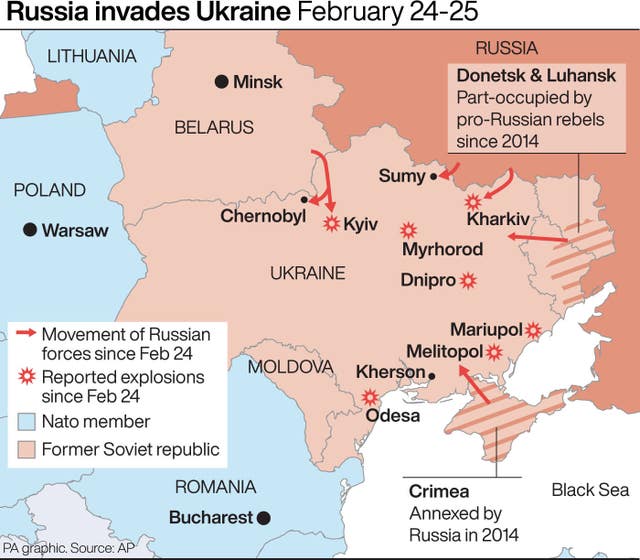Nato Secretary General Jens Stoltenberg said that US President Joe Biden and his counterparts have agreed to send parts of the organisation’s response force to help protect allies in the east following Russia’s invasion of Ukraine.
Speaking after chairing a summit in Brussels, Mr Stoltenberg said the leaders decided to send parts of the Nato Response Force and elements of a quickly deployed spearhead unit.

He did not say how many troops would be deployed, but confirmed that the move would involve land, sea and air power.
The NRF can number up to 40,000 troops, but Mr Stoltenberg said that Nato would not be deploying the entire force.
Parts of a force known in Nato jargon as the Very High Readiness Joint Task Force (VJTF), which is currently led by France, will also be sent.
“We are now deploying the Nato Response Force for the first time in a collective defence context. We speak about thousands of troops. We speak about air and maritime capabilities,” Mr Stoletenberg said.
The world’s biggest security organisation previously had around 5,000 troops stationed in the Baltic countries — Estonia, Latvia and Lithuania — and Poland, but has significantly beefed up its defences over the past three months.
Statement by #NATO Heads of State and Government on Russia's attack on #Ukraine 🇺🇦#StandWithUkraine
— NATO (@NATO) February 25, 2022
“Russia has shattered peace on the European continent. What we have warned against for months has come to pass despite all of our efforts to find a diplomatic solution,” Mr Stoltenberg said as he opened the summit.
“Moscow bears sole responsibility for the deliberate, cold-blooded and long-planned invasion,” he added.
Ahead of the summit, Mr Stoltenberg had vowed that the 30-nation military organisation would “defend every ally against any attack on every inch of Nato territory”.
Some of Nato’s 30 member countries are supplying arms, ammunition and other equipment to Ukraine, but Nato as an organisation is not. It will not launch any military action in support of Ukraine, which is a close partner but has no prospect of joining.
The Baltic members, however, have said the West should “urgently provide Ukrainian people with weapons, ammunition and any other kind of military support to defend itself as well as economic, financial and political assistance and support, humanitarian aid”.
Nato began beefing up its defences in north-eastern Europe after Russia annexed Ukraine’s Crimean Peninsula in 2014.
Recently, some members have also sent troops, aircraft and warships to the Black Sea region, near allies Bulgaria, Romania and Turkey.
Short-term, Nato has activated an emergency planning system to allow commanders to move forces more quickly. The Pentagon said Thursday that it is sending 7,000 troops to Europe in addition to 5,000 recently deployed personnel.
Nato surveillance aircraft have begun patrols inside allied territory. The planes would be able to watch Russian fighter jet and transport movements inside Ukraine, much as they monitored aircraft in Syria from Turkey’s airspace.
Lithuania declared a state of emergency on Thursday. Lithuania borders Russia’s Kaliningrad region to the south west, Belarus to the east, Latvia to the north and Poland to the south.
The Baltic country’s move allows for a more flexible use of state reserve funds and increased border protection, giving border guards greater authorities to stop and search individuals and vehicles in border areas.
“We cannot take the luxury to be (a) discussion club,” Lithuanian President Gitanas Nauseda said overnight at an emergency summit of European Union leaders held to impose a “heavy price” on Russia through sanctions.
“We need to take action.”




Comments: Our rules
We want our comments to be a lively and valuable part of our community - a place where readers can debate and engage with the most important local issues. The ability to comment on our stories is a privilege, not a right, however, and that privilege may be withdrawn if it is abused or misused.
Please report any comments that break our rules.
Read the rules hereLast Updated:
Report this comment Cancel